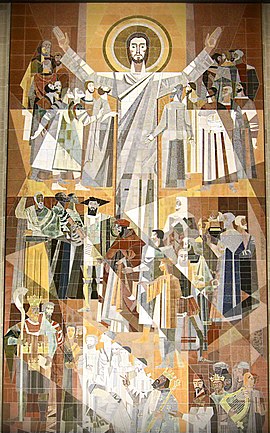| Word of Life | |
|---|---|
 | |
|
| |
| Year | 1964 |
| Location | Notre Dame, Indiana, U.S. |
| 41°42′8″N 86°14′3″W / 41.70222°N 86.23417°W | |
Word of Life (often called "Touchdown Jesus") is a mural on the side of Hesburgh Library, on the University of Notre Dame campus in Notre Dame, Indiana. The artwork measures 134 feet (41 m) high and 68 feet (21 m) wide. [1] [2]
Description
The artwork depicts a procession of figures representing Christian saints, thinkers, teachers, and writers, a topic that connected to the idea of the library. Figures were selected from different centuries and places to convey the concept of the Catholic Church's historical continuity. At the top of the procession the central figure is the resurrected Jesus Christ, conceived as the great teacher and master, and the fountain of knowledge contained in the library. The artwork, which is titled Word of Life, is 134 feet (41 m) tall and 68 feet (21 m) wide.
The mural's image of Jesus, visible from Notre Dame's football stadium, has arms raised in the same fashion as a referee signifying a touchdown. From this similarity came the mural's nickname, Touchdown Jesus. [3] A stadium expansion partially obscures views of the mural from the field.
History

The idea of a mural on the facade had been conceived early, in part for the need to decorate the large structure which otherwise would have seemed dull and resembled a large grain silo. Hesburgh was also inspired by the mosaic murals of the Central Library at the National Autonomous University of Mexico in Mexico City, which he had visited in April 1955. [2]
When the library opened in 1963, the mural had not yet been installed. American artist Millard Sheets was commissioned to create a work large enough to cover the entire side of the library facing Notre Dame's football stadium. Fr. Theodore Hesburgh suggested that the theme should be saints and scholars through the ages. The artwork cost $200,000 and was donated by Mr. and Mrs. Howard V. Phalin of Winnetka, Illinois. Installation took place in the spring of 1964; the dedication ceremony was held on May 7, 1964. The mural is composed of 324 panels. It consists of 81 different stones from 16 countries in 171 finishes that includes 46 granites and syenites, 10 gabbros and labradorites, 4 metamorphic gneisses, 12 serpentines, 4 crystalline marbles, and 5 limestones. [4]
See also
References
- ^ "Romancing the Golden Dome". Archived from the original on 2016-01-29. Retrieved 2023-08-07.
- ^ a b Grubiak, Margaret M. (November 2010). "Visualizing the modern catholic university: the original intention of "touchdown jesus" at the university of notre dame". Material Religion. 6 (3): 336–368. doi: 10.2752/175183410X12862096296847. ISSN 1743-2200. S2CID 190668799.
- ^ "Why Irish eyes are smiling". Archived from the original on 2016-03-26. Retrieved 2023-08-07.
- ^ "Hesburgh Library". Archived from the original on 2023-08-07. Retrieved 2023-08-07.
| Word of Life | |
|---|---|
 | |
|
| |
| Year | 1964 |
| Location | Notre Dame, Indiana, U.S. |
| 41°42′8″N 86°14′3″W / 41.70222°N 86.23417°W | |
Word of Life (often called "Touchdown Jesus") is a mural on the side of Hesburgh Library, on the University of Notre Dame campus in Notre Dame, Indiana. The artwork measures 134 feet (41 m) high and 68 feet (21 m) wide. [1] [2]
Description
The artwork depicts a procession of figures representing Christian saints, thinkers, teachers, and writers, a topic that connected to the idea of the library. Figures were selected from different centuries and places to convey the concept of the Catholic Church's historical continuity. At the top of the procession the central figure is the resurrected Jesus Christ, conceived as the great teacher and master, and the fountain of knowledge contained in the library. The artwork, which is titled Word of Life, is 134 feet (41 m) tall and 68 feet (21 m) wide.
The mural's image of Jesus, visible from Notre Dame's football stadium, has arms raised in the same fashion as a referee signifying a touchdown. From this similarity came the mural's nickname, Touchdown Jesus. [3] A stadium expansion partially obscures views of the mural from the field.
History

The idea of a mural on the facade had been conceived early, in part for the need to decorate the large structure which otherwise would have seemed dull and resembled a large grain silo. Hesburgh was also inspired by the mosaic murals of the Central Library at the National Autonomous University of Mexico in Mexico City, which he had visited in April 1955. [2]
When the library opened in 1963, the mural had not yet been installed. American artist Millard Sheets was commissioned to create a work large enough to cover the entire side of the library facing Notre Dame's football stadium. Fr. Theodore Hesburgh suggested that the theme should be saints and scholars through the ages. The artwork cost $200,000 and was donated by Mr. and Mrs. Howard V. Phalin of Winnetka, Illinois. Installation took place in the spring of 1964; the dedication ceremony was held on May 7, 1964. The mural is composed of 324 panels. It consists of 81 different stones from 16 countries in 171 finishes that includes 46 granites and syenites, 10 gabbros and labradorites, 4 metamorphic gneisses, 12 serpentines, 4 crystalline marbles, and 5 limestones. [4]
See also
References
- ^ "Romancing the Golden Dome". Archived from the original on 2016-01-29. Retrieved 2023-08-07.
- ^ a b Grubiak, Margaret M. (November 2010). "Visualizing the modern catholic university: the original intention of "touchdown jesus" at the university of notre dame". Material Religion. 6 (3): 336–368. doi: 10.2752/175183410X12862096296847. ISSN 1743-2200. S2CID 190668799.
- ^ "Why Irish eyes are smiling". Archived from the original on 2016-03-26. Retrieved 2023-08-07.
- ^ "Hesburgh Library". Archived from the original on 2023-08-07. Retrieved 2023-08-07.
